Aichi D3A Video - Pictures and World War II Video
|
|
Aichi D3A
D3A
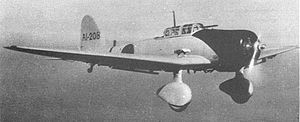
Picture - Aichi D3A1 from carrier Akagi.
Role: Carrier-based dive bomber
Manufacturer: Aichi Kokuki KK
First flight: January 1938
Introduced: 1940
Primary user: Imperial Japanese Navy
Number built: 1,486
(470 D3A1)
(1,016 D3A2)
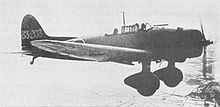
Picture - Aichi D3A1 in flight.
The Aichi D3A (Aichi-kyuu-kyuu-shiki-kanjou-bakugeki-ki), Allied reporting name "Val") was a World War II dive bomber produced by the Aichi company in Japan. It was the primary carrier-borne dive bomber in the Imperial Japanese Navy in the early stages of the war, and participated in almost all actions, including Pearl Harbor. The Aichi D3A was the first Japanese aircraft to bomb American targets in World War II. Before the war was over, it had sunk more Allied military ships than any other.
Design and development
In mid-1936, the Japanese Navy issued the 11-Shi specification for a monoplane carrier-based dive bomber to replace the existing D1A biplane currently in service. Aichi, Nakajima and Mitsubishi all submitted designs, and Aichi and Nakajima were both asked for two prototypes each.
The Aichi design started with low-mounted elliptical wings inspired by the Heinkel He 70 Blitz. It flew slowly enough that the drag from the landing gear was not a serious issue, so fixed gear were used for simplicity. The aircraft was to be powered by the 529 kW (710 hp) Nakajima Hikari 1 nine-cylinder radial engine.
The first prototype was completed in December 1937, and flight trials began a month later. Initial tests were disappointing. The aircraft was underpowered and suffered from directional instability in wide turns, and in tighter turns, it tended to snap roll. The dive brakes vibrated heavily when extended at their design speed of 370 km/h (200 kn), and the Navy was already asking for a faster diving speed of 240 kn (440 km/h).
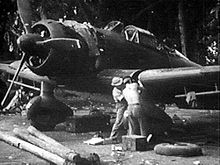
Picture - Aichi D3A2 during maintenance.
The second aircraft was extensively modified prior to delivery to try to address the problems. Power was increased by replacing the Hikari with the 626 kW (840 hp) Mitsubishi Kinsei 3 in a redesigned cowling, and the vertical tail was enlarged to help with the directional instability. The wings were slightly larger in span and the outer sections of the leading edges had wash-out to combat the snap rolls, and strengthened dive brakes were fitted. These changes cured all of the problems except the directional instability, and it was enough for the D3A1 to win over the Nakajima D3N1.
Operational history
In December 1939, the Navy ordered the aircraft as the Navy Type 99 Carrier Bomber Model 11 (kanjÅ bakugekiki, usually abbreviated to è¦ç kanbaku.). The production models featured slightly smaller wings and increased power in the form of the 746 kW (1,000 hp) Kinsei 43 or 798 kW (1,070 hp) Kinsei 44. The directional instability problem was finally cured with the fitting of a long dorsal fin, and the aircraft actually became highly maneuverable.
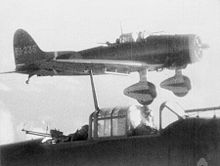
Picture - Aichi D3A from Shokaku return to their carrier after attacking the US carrier Enterprise during the Battle of the Eastern Solomons in August 1942.
Armament was two forward-firing 7.7 mm (.303 in) Type 97 machine guns, and one flexible 7.7 mm (.303 in) Type 92 machine gun in the rear cockpit for defense. Normal bombload was a single 250 kg (550 lb) bomb carried under the fuselage, which was swung out under the propeller on release by a trapeze. Two additional 60 kg (130 lb) bombs could be carried on wing racks located under each wing outboard of the dive brakes.
The D3A1 commenced carrier qualification trials aboard the Akagi and Kaga during 1940, while a small number of aircraft made their combat debut from land bases over China. Starting with the attack on Pearl Harbor, the D3A1 took part in all major Japanese carrier operations in the first 10 months of the war. They achieved fame during the Indian Ocean raid in April 1942 when the D3A1s scored with over 80% of their bombs during attacks on the British cruisers HMS Cornwall and Dorsetshire and the carrier HMS Hermes. In some cases, they were pressed into duty as fighters, their maneuverability being enough to allow them to survive in this role.
In June 1942, an improved version of the D3A powered by a 969 kW (1,300 hp) Kinsei 54 was tested as the Model 12. The extra power reduced range, so the design was further modified with additional fuel tanks to bring the total tankage to 900 L (240 US gal, giving it the range needed to fight effectively over the Solomon Islands. Known to the Navy as the Model 22, it began to replace the Model 11 in front-line units in autumn 1942, and most Model 11s were then sent to training units.
When the Yokosuka D4Y Suisei became available, the D3A2s ended up with land-based units or operating from the smaller carriers, which were too small to handle the fast-landing Suisei. When American forces recaptured the Philippines in 1944, land-based D3A2s took part in the fighting, but were hopelessly outdated and losses were heavy. By then, many D3A1s and D3A2s were operated by training units in Japan, and several were modified with dual controls as Navy Type 99 Bomber Trainer Model 12s (D3A2-K). During the last year of the war, the D3A2s were pressed back into combat for kamikaze missions.
In 1945, Indonesian guerillas captured numerous ex-Japanese air bases. Several "Vals" were captured by Indonesian guerillas, including at Bugis Air Base in Malang (repatriated 18 September 1945). Most of the aircraft were destroyed during the Indonesian National Revolution in 1945-1949 when the former Dutch East Indies and the Netherlands were engaged in military conflict/police action in Indonesia.
Operators
Japan
Imperial Japanese Navy Air Service
Postwar Indonesia
Indonesia - Postwar
Survivors
One D3A is currently under restoration at the Planes of Fame Museum in Chino, California.
Specifications (D3A1)
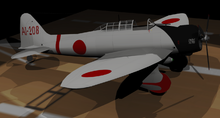
Picture - D3A2 with Type 98 bomb
General characteristics
Crew: Two (pilot and gunner)
Length: 10.2 m (33 ft 5 in)
Wingspan: 14.37 m (47 ft 2 in)
Height: 3.85 m (12 ft 8 in)
Wing area: 34.9 m² (375.6 ft²)
Empty weight: 2,408 kg (5,309 lb)
Max takeoff weight: 3,650 kg (8,047 lb)
Powerplant: 1x Mitsubishi Kinsei 44, 798 kW (1,070 hp)
Performance
Maximum speed: 389 km/h (205 kn, 242 mph)
Range: 1,472 km (795 nmi, 915 mi)
Service ceiling: 9,300 m (30,500 ft)
Armament
2 x fixed, forward-firing 7.7 mm (0.303 in) Type 97 machine guns
1 x flexible, rearward-firing 7.7 mm (0.303 in) Type 92 machine gun
1 x 250 kg (551 lb) or 2 x 60 kg (132 lb) bombs
Specifications (D3A2)

Picture - Aichi D3A2 with telescopic sight before take off.
Data from
General characteristics
Crew: Two (pilot and gunner)
Length: 10.2 m (33 ft 5.4 in)
Wingspan: 14.37 m (47 ft 2 in)
Height: 3.8 m (12 ft 7.5 in)
Wing area: 34.9 m² (375.6 ft²)
Empty weight: 2,570 kg (5,666 lb)
Max takeoff weight: 4,122 kg (9,100 lb)
Powerplant: 1x Mitsubishi Kinsei 54, 969 kW (1,300 hp)
Performance
Maximum speed: 430 km/h (232 kn, 267 mph)
Range: 1,352 km (730 nmi, 840 mi)
Service ceiling: 10,500 m (34,450 ft)
Rate of climb: 8.62 m/s (1,869.685 ft/min)
Armament
2 x fixed, forward 7.7 mm (0.303 in) Type 97 machine guns
1 x flexible, rearward-firing 7.7 mm (0.303 in) Type 92 machine gun
1 x 250 kg (551 lb) or 2 x 60 kg (132 lb) bombs
Comparable aircraft
Blackburn Skua
Breda Ba.65
Curtiss SB2C Helldiver
Douglas Dauntless
Fairey Barracuda
Junkers Ju 87
Vultee Vengeance
Yokosuka D4Y
Related lists
List of bomber aircraft
List of military aircraft of Japan
Bibliography
Angelucci, Enzo and Paolo Matricardi. World Aircraft: World War II, Volume II (Sampson Low Guides). Maidenhead, UK: Sampson Low, 1978. ISBN 0-562-00096-8.
Chant, Christopher. Aircraft of World War II - 300 of the World's Greatest Aircraft 1939-45. London: Amber Books Ltd., 1999. ISBN 0-7607-1261-1.
Fleischer, Seweryn and Zygmunt Szeremeta. Aichi D3A Val, Nakajima B5N Kate (in Polish). Warszawa, Poland: Wydawnictwo Militaria, 2001. ISBN 83-7219-118-2.
Francillon, René J. Japanese Aircraft of the Pacific War. London: Putnam & Company Ltd., 1970 (2nd edition 1979). ISBN 0-370-30251-6.
Francillon, René J. Japanese Bombers of World War Two, Volume One. Windsor, Berkshire, UK: Hylton Lacy Publishers Ltd., 1969. ISBN 0-85064-022-9.
Kinzey, Bert. Attack on Pearl Harbor: Japan awakens a Sleeping Giant. Blacksburg, VA: Military Aviation Archives, 2010. ISBN 978-0-9844665-0-4.
"Pacific Predator... the Aichi Type 99". Air International, December 1987, Vol. 33, No. 6, pp. 285-290. Bromley, UK: Fine Scroll. ISSN 0306-5634.
Parshall, Jonathan and Anthony Tully. Shattered Sword: The Untold Story of the Battle of Midway. Washington D.C.: Potomac Books Inc., 2007. ISBN 978-1-57488-924-6.
Richards, M.C. and Donald S. Smith. "Aichi D3A ('Val') & Yokosuka D4Y ('Judy') Carrier Bombers of the IJNAF". Aircraft in Profile, Volume 13. Windsor, Berkshire, UK: Profile Publications Ltd., 1974, pp. 145-169. ISBN 0-85383-022-3.
Smith, Peter C. Aichi D3A1/2 Val . Ramsbury, Marlborough, Wiltshire, UK: The Crowood Press Ltd., 1999. ISBN 1-86126-278-7.
Tagaya, Osamu. Aichi 99 Kanbaku 'Val' Units of World War 2. Botley, UK: Osprey Publications, 2007. ISBN 1-84176-912-7.
Aichi D3A Pictures and Aichi D3A for Sale.
Living Warbirds: The best warbirds DVD series.
Source: WikiPedia